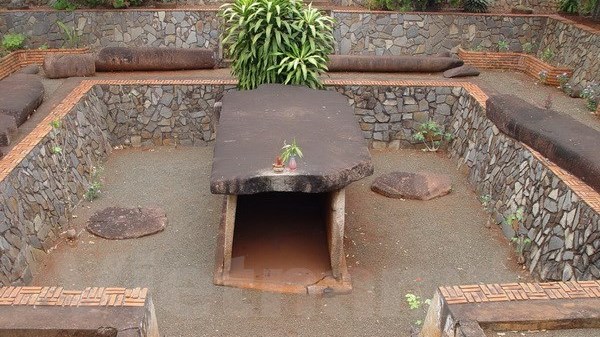The Dong Nai provincial People's Committee held a ceremony on November 22 to announce the Prime Minister's Decision and receive a certificate recognising the Cu Thach Hang Gon ancient tomb as a national special relic site and Tran Bien Temple of Literature as a national historical relic.

The Cu Thach Hang Gon ancient tomb (Photo: vietnamplus.vn)
The Cu Thach Hang Gon ancient tomb was built around 2,000 years ago and is one of Asia’s largest stone chambers. Also known as a dolmen, the tomb is so far bigger than any other dolmen discovered in Jordan, north Myanmar and Java.
The rectangular parallelepiped tomb is 4.2m long and 2.7m wide, and comprised of four upright stones with a curved capstone at the foundation.
The ancient tomb was discovered by French civil engineer Jean Bouchot in 1927 while working on a project to construct a road from Long Khanh to Ba Ria.
In reports sent to the Ecole Francaise d’Extreme Orient from 1927 to 1930, Bouchot wrote “the tomb contained many stone rings, pottery and several small earthen bottles, inside of which were layers of brown soil and ash.” Recent excavations, however, have revealed that the ancient tomb contains none of these items.
From reading Bouchot’s initial reports, archaeologists now believe that Cu Thach was originally used as a common tomb for a group of Polynesians. They understand that these people were most likely ancestors of the ethnic Ma, Ch’ro and S’tieng people who now inhabit the Central Highlands and eastern provinces of southern Viet Nam.
The tomb is located inside the Hang Gon Rubber Plantation in Dong Nai Province, just 3km from the Tan Phong intersection and not far from a road that leads towards Ba Ria-Vung Tau. The curved capstone of the tomb is over 30cm thick, and wider than the four upright stones. Historian Nguyen Dinh Dau said the capstone weighed in at over 10 tonnes.
Tran Bien Temple of Literature is located in Buu Long Ward, Bien Hoa City, of Dong Nai.
Built in 1715 under Lord Nguyen Phuc Chu, it was the first temple of its kind in the South. It is a place to honour Confucius and also serves as an educational centre.
The site was destroyed by the French in 1861 and later restored in 1998. It has become a popular destination for tourists who want to learn more about the history of Viet Nam through the stories of national heroes and the country’s cultural personalities.